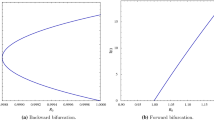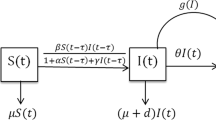Abstract
This paper presents the numerical properties of a reaction–diffusion susceptible–infected–susceptible epidemic model. Comparing with existing literature, our numerical scheme gains advantage in terms of preserving the biological meanings (such as positivity or invariance of total population) unconditionally. An implicit–explicit technique is implemented in the time integration, which ensures the numerical positivity without CFL conditions while reducing the computation complexity. The solvability, convergence in finite time and the long-time behaviors of numerical solutions are investigated. A threshold value \(R_{0}^{\Delta x}\) for the long-time dynamics of numerical solutions is proposed, which is named as a numerical basic reproduction number. It is proved that the numerical disease-free equilibrium is locally asymptotically stable if \(R_{0}^{\Delta x}<1\) and unstable if \(R_{0}^{\Delta x}>1\). It is presented that \(R_{0}^{\Delta x}\) shares the same monotonicity and limits as the basic reproduction number of the underlying model and converges to the exact one. Some numerical experiments are given in the end to confirm the conclusions and explore the stability of the endemic equilibrium.


























Similar content being viewed by others
References
Allen LJS, Bolker BM, Lou Y, Nevai AL (2008) Asymptotic profiles of the steady states for an SIS epidemic reaction–diffusion model. Discrete Contin Dyn Syst 21:1–20
Boscarino S, Bürger R, Mulet P, Russo G, Villada LM (2015) Linearly implicit IMEX Runge–Kutta methods for a class of degenerate convection–diffusion problems. SIAM J Sci Comput 37:B305–B331
Brauer F, Chavez CC (2001) Mathematical models in population biology and epidemiology. Springer, New York
Bürger R, Mulet P, Villada LM (2013) Regularized nonlinear solvers for IMEX methods applied to diffusively corrected multispecies kinematic flow models. SIAM J Sci Comput 35(3):B751–B777
Bürger R, Inzunza D, Mulet P, Villada LM (2019) Implicit-explicit methods for a class of nonlinear nonlocal gradient flow equations modelling collective behaviour. Appl Numer Math 144:234–252
Chen S, Shi J (2020) Asymptotic profiles of basic reproduction number for epidemic spreading in heterogeneous environment. SIAM J Appl Math 80:1247–1271
Deng K, Wu Y (2016) Dynamics of a susceptible-infected-susceptible epidemic reaction–diffusion model. Proc R Soc Edinb A 146(05):929–946
Galeone L (1983) The use of positive matrices for the analysis of the large time behavior of the numerical solution of reaction–diffusion systems. Math Comput 41(164):461–472
Galeone L, Lopez L (1982) Decay to spatially homogeneous states for the numerical solution of reaction–diffusion systems. Calcolo 19(2):193–208
Hoff D (1978) Stability and convergence of finite difference methods for systems of nonlinear reaction-diffusion equations. SIAM J Numer Anal 15(6):1161–1177
Li H, Rui P, Wang FB (2017a) Varying total population enhances disease persistence: qualitative analysis on a diffusive SIS epidemic model. J Differ Equ 262(2):885–913
Li B, Li H, Tong Y (2017b) Analysis on a diffusive SIS epidemic model with logistic source. Z Angew Math Phys 68:68–96
Luciano L (1983) Stability and asymptotic behaviour for the numerical solution of a reaction diffusion model for a deterministic diffusive epidemic. IMA J Numer Anal 3:341–351
Magal P, Webb GF, Wu Y (2019) On the basic reproduction number of reaction–diffusion epidemic models. SIAM J Appl Math 79:284–304
Poole G, Boullion T (1974) A survey on M-matrices. SIAM Rev 16:419–427
Rui P, Liu S (2009) Global stability of the steady states of an SIS epidemic reaction–diffusion model. Nonlinear Anal 71(1–2):239–247
Rui P, Zhao XQ (2012) A reaction–diffusion SIS epidemic model in a time-periodic environment. Nonlinearity 25(5):1451–1471
Santonja FJ, Sánchez E, Rubio M, Morera JL (2010) Alcohol consumption in Spain and its economic cost: a mathematical modeling approach. Math Comput Model 52(7–8):999–1003
Tuncer N, Martcheva M (2012) Analytical and numerical approaches to coexistence of strains in a two-strain SIS model with diffusion. J Biol Dynam 6(2):406–439
Varah JM (1975) A lower bound for the smallest singular value of a matrix. Linear Algorithm Appl 11(1):3–5
Wang W, Zhao XQ (2012) Basic reproduction numbers for reaction-diffusion epidemic models. SIAM J Appl Dyn Syst 11:1652–1673
Yang C, Wang J (2020) Basic reproduction numbers for a class of reaction–diffusion epidemic models. B Math Biol 82(8)
Zhang J, Cui R (2020) Qualitative analysis on a diffusive SIS epidemic system with logistic source and spontaneous infection in a heterogeneous environment. Nonlinear Anal-Real 55:103115
Author information
Authors and Affiliations
Corresponding author
Additional information
Communicated by Rafael Villanueva.
Publisher's Note
Springer Nature remains neutral with regard to jurisdictional claims in published maps and institutional affiliations.
Rights and permissions
Springer Nature or its licensor (e.g. a society or other partner) holds exclusive rights to this article under a publishing agreement with the author(s) or other rightsholder(s); author self-archiving of the accepted manuscript version of this article is solely governed by the terms of such publishing agreement and applicable law.
About this article
Cite this article
Liu, X., Yang, Z.W. Numerical analysis of a reaction–diffusion susceptible–infected–susceptible epidemic model. Comp. Appl. Math. 41, 392 (2022). https://doi.org/10.1007/s40314-022-02113-9
Received:
Revised:
Accepted:
Published:
DOI: https://doi.org/10.1007/s40314-022-02113-9




